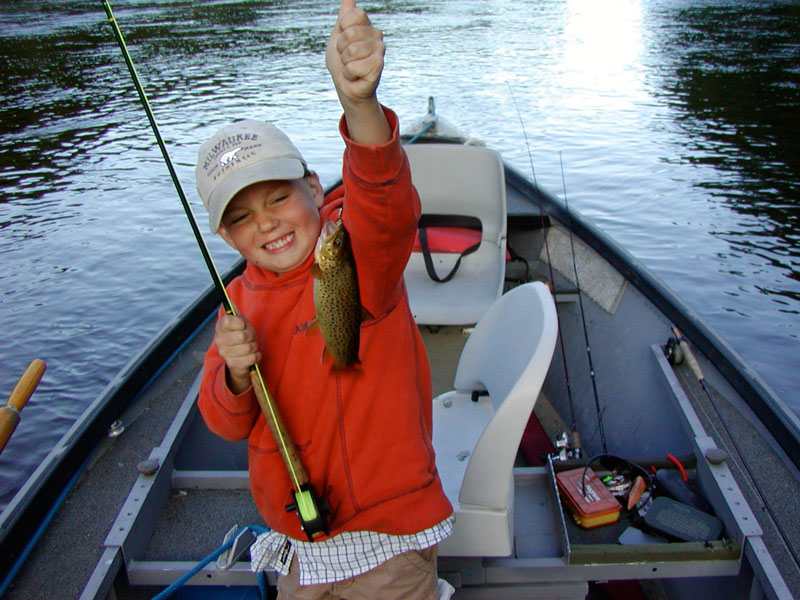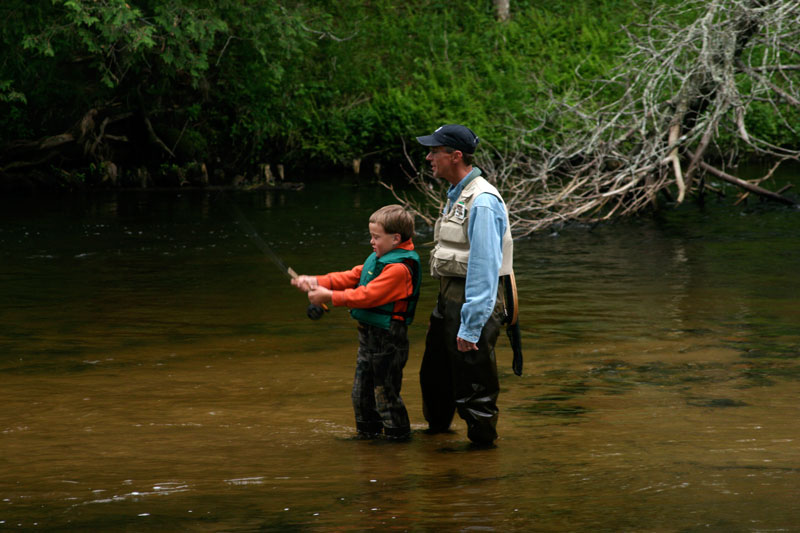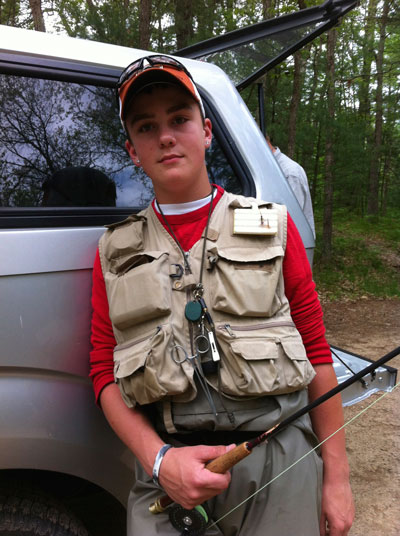I ran across a recent post on a Facebook fly fishing group where an angler was asking for helping getting his child interested in fly fishing and away from his youthful, digital lifestyle. As expected, the advice he received ranged from basic common sense to extreme beatings and violent disposal of his iPad and video games involving guns and explosives.
I don’t profess to be the Doctor Spock of child rearing but I feel I have successfully passed on the hunting and fishing traditions to my sons – who now qualify as certified outdoor addicts and teenagers. To that end, I owe much of that success to sound advice and mentoring to gentleman much older and wiser than myself – which I will pass along to you.
Rule #1 : When you take a kid fishing, leave your rod at home.
The day is about them, not you. When they become accomplished anglers, you can begin to bring your rod along on day trips and fish along side them. I personally need to thank retired Michigan fly fishing guide, Robert Nicholson, for this sage advice. Having tried to bend that rule a few times unsuccessfully, I realized it’s nearly impossible to properly teach someone to fish while trying to fish yourself — for all the same reasons a guide does not fish when they are with clients.
Rule #2: Take them someplace they are absolutely going to catch fish.
If you intend to inspire a child to enjoy fishing, they need to catch fish – a lot of them. Catching IS the point of the exercise – for young and old anglers alike. Young anglers who are forced to endure countless hours of fishless fishing are unlikely to develop a love for the sport. Let’s face it, if you successfully pass along the fly fishing bug to a child they will have a life time of fishless hours without any help from you at all.
Rule#3: Embrace technology.
For millennial children, technology is as much a part of their life as a car, a house or any other element that is part of today’s society (if not larger). While a child may eventually find the outdoors a great escape from technology and the burdens of daily life, forcing a confrontation over technology is counterproductive to your task. Take digital pictures, make memories and encourage them to make movies of your day fishing on phones or tablets. Facebook it, Instagram it, Tweet it – celebrate your time in the outdoors on a level they relate to. If the kid wants to get lost in Candy Crush on the long drive to and from the river, so be it. Eventually, once they catch the fly fishing bug, they’ll hopefully spend that drive time asking for tips and tricks on presentation, flies, or recounting tales of past trips.
Rule #4: Learn to fly fish down and across, on the swing.
Learning the art of the drag free drift is difficult. Whether you are fishing a dry fly or bouncing a nymph, learning the skills sets to accomplish this task comes with great challenges. The beauty of swinging a classic wet fly down and across stream is that no matter how poorly it’s done, at some point in the swing, the spirits of the river will straighten the line and present the fly properly (if even for a brief moment) and the caster WILL catch fish – consistently, without frustration.
Despite the unpopularity of classic, winged wet flies in America, there is no denying the effectiveness of flies that have been consistently catching trout for over a century. A Greenwell’s Glory (in an appropriate size) will fish any water for an Olive. An Invicta will fish on any caddis water and the Hendrickson, Queen of the Waters, March Brown and Professor will excel during mayfly hatches.
As the child becomes slightly better at casting, add a dropper fly to the leader and introduce a prince nymph, hare’s ear or pheasant tail nymph to the team. Teach the child to mend line above the fly after the cast, and allow the fly to dangle before picking up the cast. A lot of fish will be caught on the dangle and the longer the fly dangles the better the odds.
Another beauty of down and across is that on a tight line, you feel the fish take the fly with a heart-stopping, rod yanking thump. A well-timed hook set isn’t necessary for success, as fish 99% of the time fish will hook themselves. Just lift the rod tip lightly to meet the fish.
When it all comes together.
Last spring my angling friend and I sat on the banks of a popular Michigan River and watched my youngest son working a team of wet flies, down and across stream through a run that was dotted with occasional rises. Every third cast or so he was picking up a fish. Most were in the 8-inch range but he landed three fish in the 12-14” range and couple of dozen dinks before the evening rise had ended. With each catch he looked back smiling, waving and holding up fish.
About halfway through the evening my long time fishing friend, who had taught my son to cast, nudged me and pointed to anglers up stream and downstream of my son and said with a smile, “He has an audience.”
I watched a graying angler downstream struggle with rising fish refusing his offerings. The angler above us, in his mid-twenties, was bouncing a nymph rig and bobber in head of the pool with little success — all while my son, unaware, laughed and giggled as he stripped in fish after fish.
As twilight faded, and darkness began to overtake the skies above the river, we watched as my son waded out of the run at the boat launch and he was met by the other two anglers. We were too far away to hear the conversation, but we could see my son opening his fly boxes and pointing inside as he talked to the fisherman.
My friend shifted his weight on the bank and pulled his zippo from his fly vest. The familiar “clink” of the lid bounced off the water below us. He lit his pipe, inhaled deeply then turned to me with a smile and stated, “My work here is done.”
I couldn’t agree more.
No matter how old I get, I’ll never comprehend why down and across fishing for trout has never risen to great popularity in fly fishing circles (beyond the latest Spey craze). Perhaps, it’s just too easy.
Regardless of your preferences for presentation, with regard to lowering the barrier of entry to the sport, teach a kid to swing flies and be happy. You can work on the complex presentations later.
Most importantly, make it fun. With any luck, you’ll soon find the days of your kids out-fishing you and you’ll be loving it.





